
This is a heart-wrenching story from Carter Niemeyer about the on-going persecution of wolves in Idaho at the hands of the state and federal government.
The Smokey Wire : National Forest News and Views
Community Sourced, Shared and Supported

This is a heart-wrenching story from Carter Niemeyer about the on-going persecution of wolves in Idaho at the hands of the state and federal government.
Yesterday afternoon, I noticed on Twitter that the National Weather Service in Medford, Oregon identified pyrocumulus clouds coming from the Bootleg Fire.
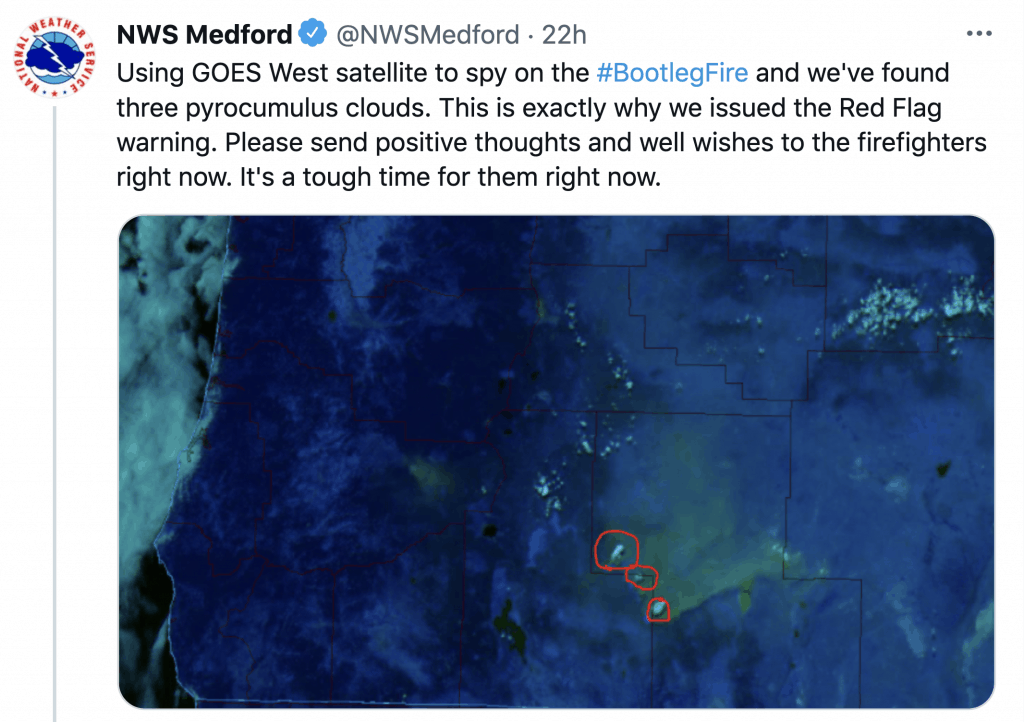
So, I decided to have a closer look at what the landscape where those pyrocumulus clouds were coming from looked like. Here’s what I found.
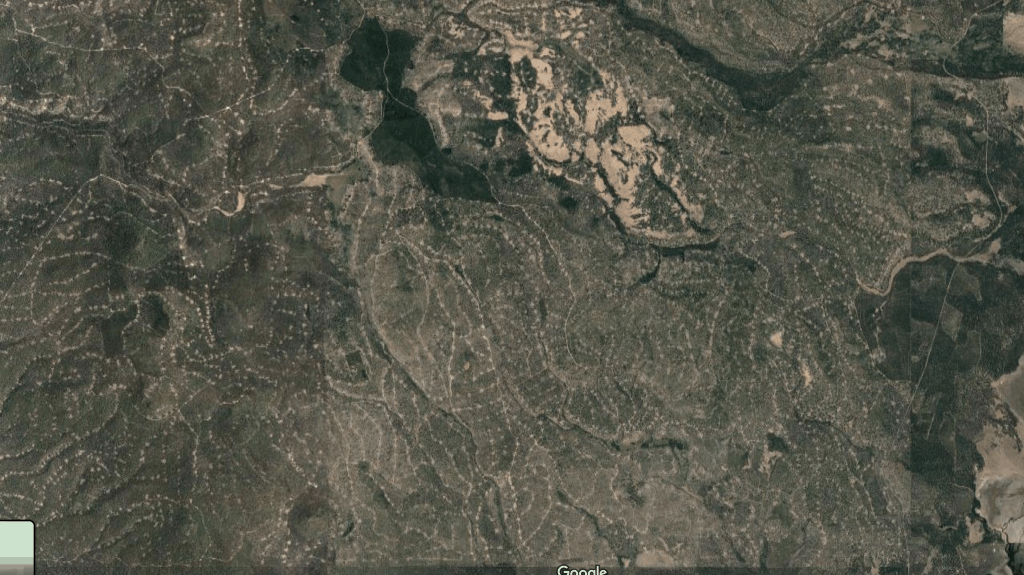
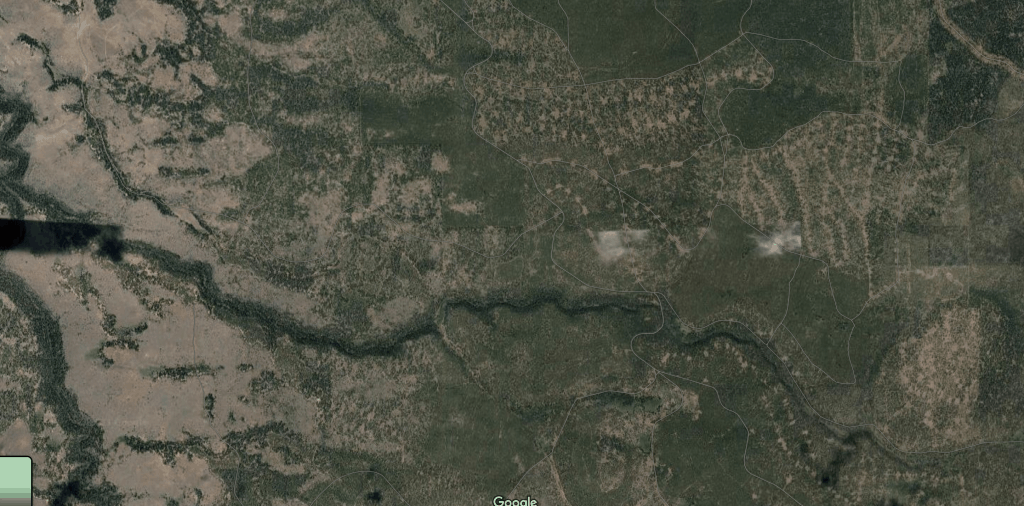
It appears that much of the area burning hot was very heavily logged/roaded/managed. Also, this is clearly a dry-east side forest, not the lush Oregon forest many people outside of the region may assume when they hear that a big “forest fire” is burning in Oregon.
Next, I started hearing from numerous sources that the heavily logged/roaded and ‘managed’ area where the Bootleg Fire ripped and roared through yesterday—putting up those pyrocumulus clouds—is allegedly part of a huge biomass energy, “forest offset” (ie “carbon offset) logging project.
CarbonPlan sent out numerous tweets stating:
As the #BootlegFire burns out of control in Oregon — with critical implications for public safety, air quality, and forest health — we can report that another large forest offset project appears to be on fire.
And this:
The project impacted by the #BootlegFire, ACR273, is a 400,000 acre forest project that was recently harvested for timber and has earned more than 950,000 offset credits from California’s climate regulator as it regrows. acr2.apx.com/mymodule/reg/p
I also have noticed a number of tweets from Gary Graham Hughes of Biofuels Watch, which included information such as this:
Extreme fire behavior is a result of the logging. You are missing the #climate ironies of an offset project going up in smoke plus the tens of millions of dollars of public money for Red Rock Biofuels unicorn bioenergy project that has never yet produced even one gallon of fuel.
And this:
The fire is exploding through heavily logged lands belonging to Green Diamond Resource Company, holdings that are registered as an offset project for California cap-and-trade as well as been committed to provide feedstock for the unicorn #RedRockBiofuels project in #Lakeview.
I also couldn’t help but notice this tweet from the John Muir Project:
Satellite imagery of the #BootlegFire area (perimeter updated on July 13, 2021) from 1985 to 2020. Note large swaths of land that have been "managed",clearcut, logged, & thinned during this time frame. @forestservice #StopTheChop #ListenToScience
Footage: Bryant Baker
Stay safe pic.twitter.com/JJKV2Q98SH— John Muir Project (@JohnMuirProject) July 15, 2021
Or this map produced by Bryant Baker (MS) of Los Padres Forest Watch of the management history of the Bootleg Fire area.
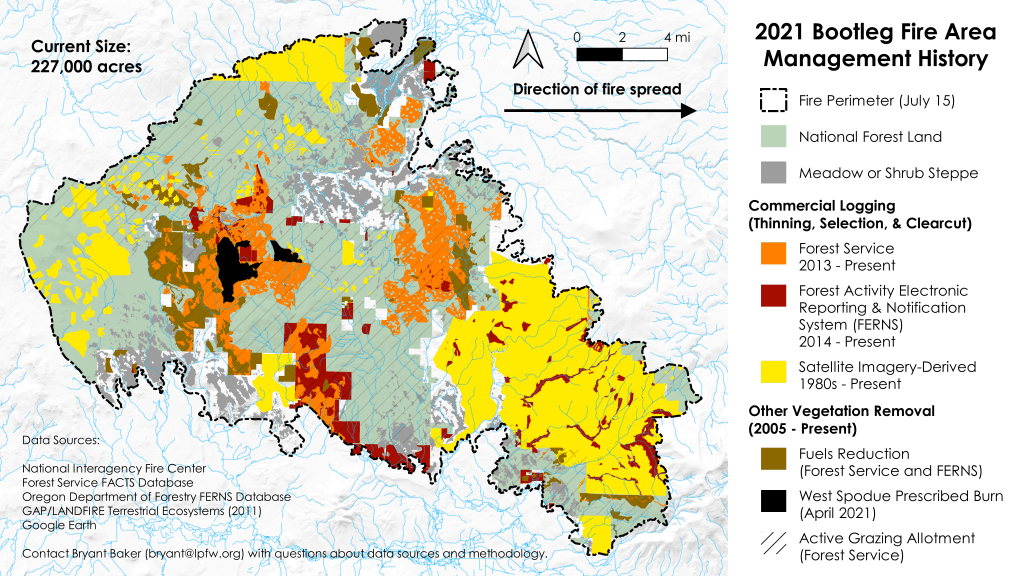
I’m sure in the coming days and weeks we’ll end up learning more. It goes without saying that this part of the country just experienced some of the highest temperatures on record (and it was 121 degrees in…Canada). And this part of the world is also currently under exceptional drought or extreme drought.
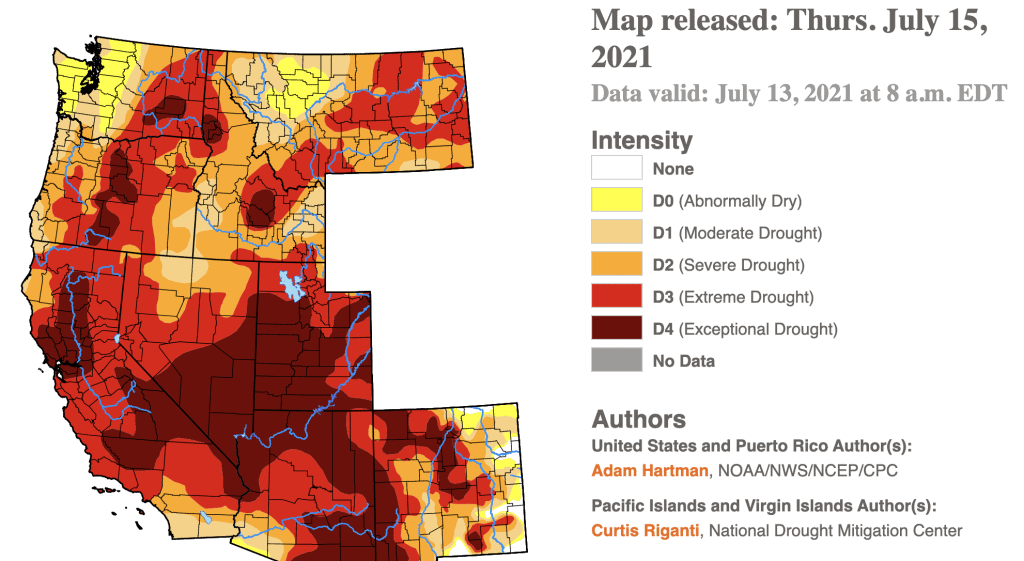
If all of this sounds sort of familiar it’s because it should be. The same situation just played out in Oregon ten months ago during the deadly and destructive Labor Day fires. Speaking of those fires, and also the role that downed power lines have played in some of the most deadly and destructive wildfires in recent years, Oregon Public Broadcasting just published this story, “Residents of Gates, Oregon, aim their ire at Pacific Power nearly a year after their town burned: Despite high wind warnings, Pacific Power chose not to shut off electricity.”
According to Inciweb, the cause of the Bootleg Fire is currently “unknown.” Inciweb also reports, “Fire remains very active with significant acreage increases due to hot, dry, and breezy conditions, and plume-dominated fire behavior. Poor humidity recovery at night is contributing to active fire spread through the night time period. Robust spread rates are being generated by drought-affected fuels. Expecting similar conditions for the next several days.”
Stay safe everyone. And pray for rain…and climate action and more climate resilient communities and infrastructure. It’s going to be a long century.
UPDATE (July 20, 2021): According to InciWeb, on July 19th, the Bootleg Fire merged into the Log Fire to its northeast and now is being managed as one fire. Total acres burned to date are 388,359 acres. The cause is still “unknown.”
This is the aerial view of the northern part of the Bootleg Fire, again showing how heavily logged and roaded this specific part of the fire area is.

Also, here’s an updated map produced by Bryant Baker (MS) of Los Padres Forest Watch showing the management history of the Bootleg Fire area.
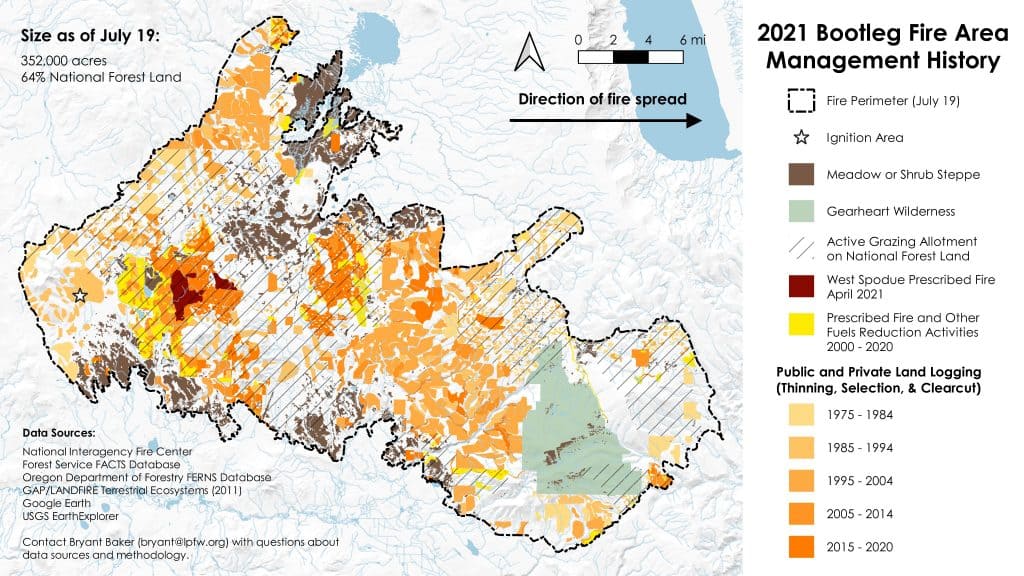
UPDATE (July 21, 2021): These new maps from Oregon Wild illustrate the extent of logging and grazing across the Bootleg Fire footprint.
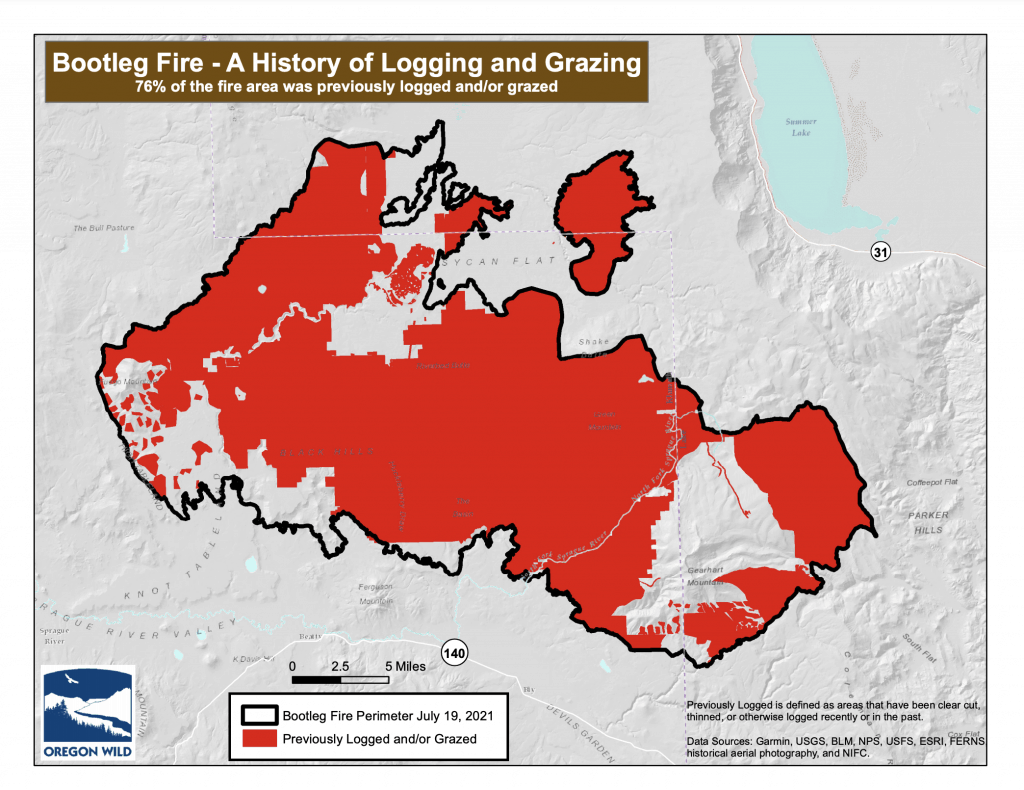
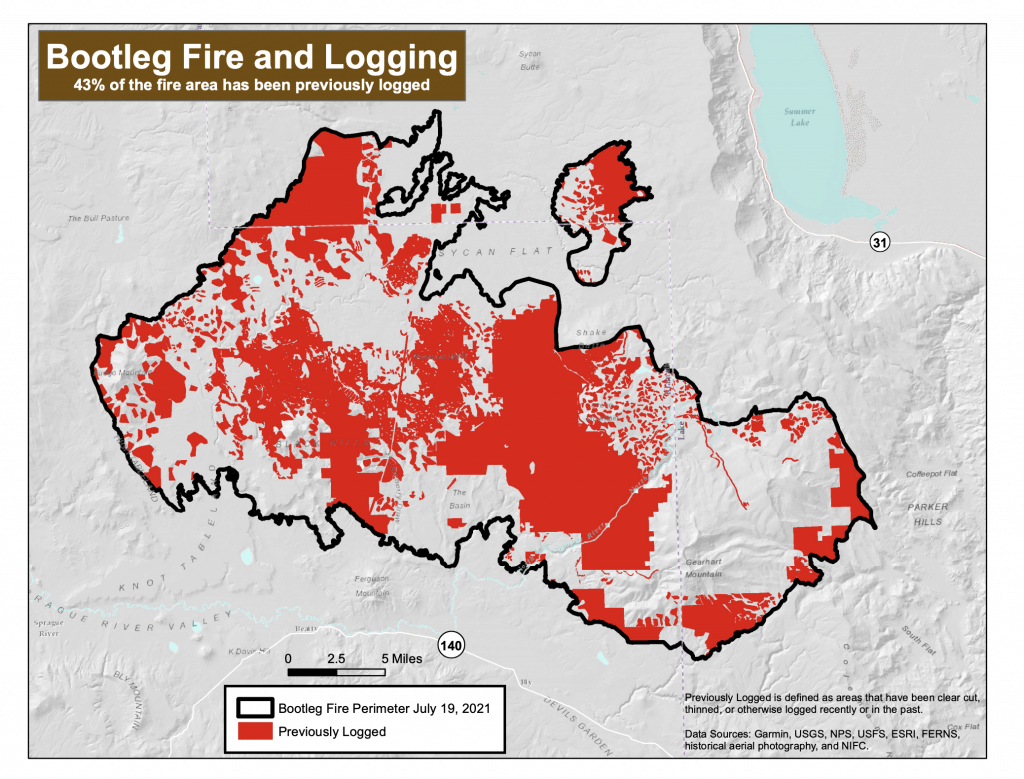

“We’ve been disrespected all our lives,” said resident Belinda Joyner, 68, who has been fighting environmental racism in her community for decades, “and we’re still being disrespected.”
Check out the huge story feature from CNN on how the wood pellet industry is harming communities, destroying local economies and gobbling up forests all in the name of climate change even though it is hurting the climate not helping.
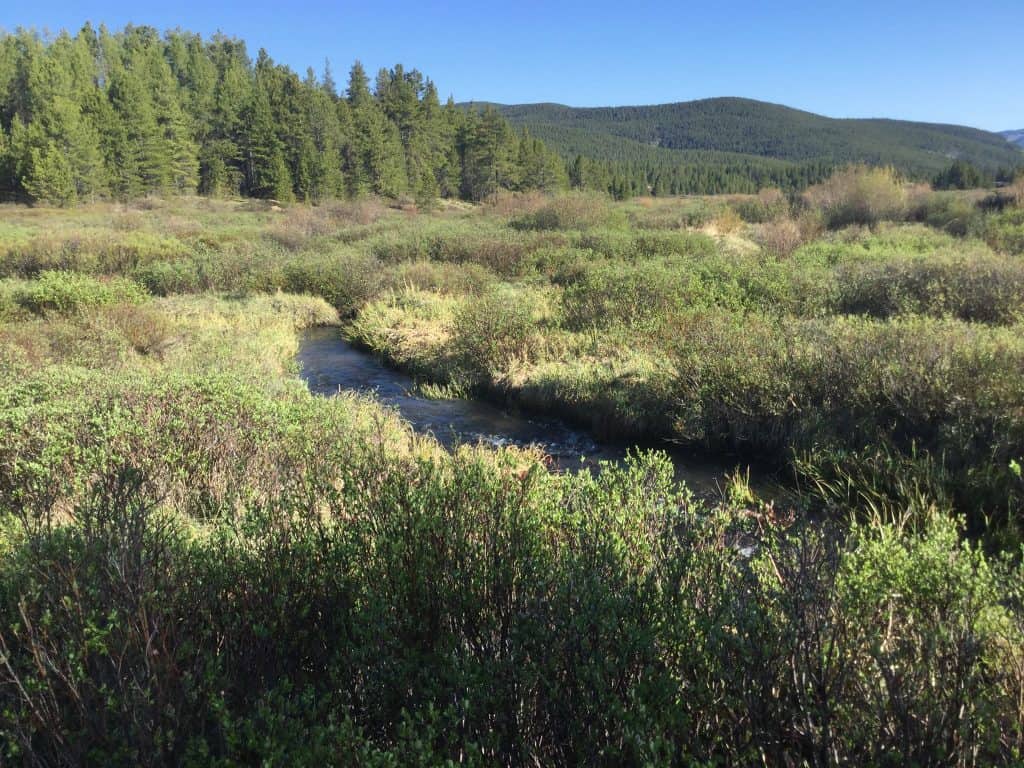
Readers of The Smokey Wire may recall that Sharon posted about this project last November. You can check out that post and discussion/debate here. Below is the latest development.
DENVER—To safeguard irreplaceable wetlands and imperiled species in the headwaters of the Colorado River, a coalition of conservation groups today warned the U.S. Forest Service and U.S. Fish and Wildlife Service that they will file a lawsuit in federal court if the agencies do not complete a comprehensive analysis of the effects of the planned and permitted geotechnical investigation on the greenback cutthroat trout and Canada lynx.
The Forest Service issued a special use permit for the Whitney Creek Geotechnical project on March 22, 2021. The feasibility assessment is the first step by the Cities of Colorado Springs and Aurora to build another large dam and reservoir in the Homestake Valley in the White River National Forest for diversion out of the Colorado River Basin to the Front Range.
“Nature’s bank account is severely overdrawn due to climate change and unsustainable use,” said Jen Pelz, the Wild Rivers Program Director at WildEarth Guardians. “The solution is not to build a bigger bank, but to conserve water, protect land and wildlife, and start living within the river’s means.”
The letter sent by WildEarth Guardians, Colorado Headwaters, Holy Cross Wilderness Defense Fund, Save the Colorado, the Colorado Chapter of the Sierra Club, and Wilderness Workshop details how the agencies failed to consider the effects of the investigative drilling, as well as the forthcoming dam and reservoir project, on listed species in violation of the Endangered Species Act. Listed species identified that exist in or downstream of the project include the threatened Canada lynx, Greenback cutthroat trout, and Ute Ladies’-tresses orchid, and the endangered bonytail chub, Colorado pikeminnow, humpback chub, and razorback sucker.
“After reviewing the record it’s clear that the U.S. Forest Service and the U.S. Fish & Wildlife Service failed to comply with the Endangered Species Act. The real impacts to listed species, including lynx and cutthroat trout, haven’t been adequately considered or disclosed,” said Peter Hart, Staff Attorney at Wilderness Workshop. “Today’s letter puts the agencies on notice of the violations we’ve identified; they now have 60 days to respond. If the issues we’ve raised remain unresolved, we could pursue a legal challenge in federal court.”
In addition to the harm to imperiled species detailed in the notice letter, the investigative drilling proposed along Homestake Creek in Eagle County, Colorado could drain and destroy valuable wetlands. Further, the exploration will lay the foundation for a destructive reservoir that would inundate hundreds of acres in the Holy Cross Wilderness Area while stealing more water from the Colorado River to the thirsty front range for use by the Cities of Colorado Springs and Aurora.
The groups urge the Forest Service and the Fish and Wildlife Service to conduct a comprehensive analysis of the effects of the geotechnical investigation and related activities on threatened and endangered species as required by the Endangered Species Act before any investigatory drilling or other activities are undertaken in the Homestake Valley. If the agencies fail to do so, the groups will file a lawsuit in federal court after the 60-day notice period is complete.
“Colorado has not seen a transmountain diversion in 45 years. With climate change and the Colorado River losing 1% of flows each year, the Aurora and Colorado Springs’ Homestake project will never be built,” said Jerry Mallett, President of Colorado Headwaters
“Not one drop, not one,” said Gary Wockner of Save The Colorado. “Buckle up, because we will fight to stop this proposed new Colorado River dam and diversion project for as long and as hard as it takes.” Gary Wockner, Executive Director, Save The Colorado
“It is unfortunate that the U.S. Forest Service has chosen to facilitate the construction of a dam near a wilderness area in order to transfer yet more water from the West Slope to cities in the Front Range. The proposed dam and reservoir would drown wetlands and riparian habitat, which are naturally rare in the arid west comprising just 2 percent of the landscape,” explained Ramesh Bhatt, Chair, Conservation Committee of the Colorado Sierra Club. “Despite their rarity, wetland ecosystems are needed by greater than 80 percent of our native wildlife during some phase of their life cycle. Building this dam would be another devastating blow to Colorado’s biodiversity, which is already in crisis. This action by the Forest Service is not only contrary to its mandate to protect natural areas but is also illegal because the Service chose to cut corners to make its decision.”
“The proposed Whitney Creek project starting with destructive drilling of the irreplaceable Homestake Creek wetlands is an environmental atrocity and must be abandoned. The permit for drilling must be revoked. It is premised on several fallacies: that it will not damage the wetlands, that it will determine that there is no geologic reason not to build the proposed Whitney Creek Reservoir, and that the reservoir will be built. None of these things are true,” said Warren M. Hern, Chairman, of Holy Cross Wilderness Defense Fund. “The permit assumes that Congress will approve a loss of 500 acres from the Holy Cross Wilderness, which we will oppose, which the public will oppose, and which will not be approved by the Congress. Aside from irrevocable destruction of the Homestake Creek wetlands at and downstream from the proposed reservoir, the proposed reservoir is placed over a major geological fault, the Rio Grande Rift, which is a tectonic divergent plate boundary. Placing a reservoir at this site is pure madness and terminal stupidity. It would endanger the lives of those living downstream. We will oppose it by every legal means available.”
During this WildEarth Webinar, which was recorded on June 9, 2021, our guests Dr. Chad Hanson and Dr. Monica Bond cut through years of misinformation and misdirection to make an impassioned, evidence-based argument for a new paradigm of fire and forest management.
Chad Hanson is a research ecologist and director of the John Muir Project of Earth Island Institute, located in Big Bear City, California. Dr. Hanson has a Ph.D. in ecology with a research focus on fire ecology in conifer forest ecosystems. He is the author of the 2021 book, Smokescreen: Debunking Wildfire Myths to Save Our Forests and Our Climate, and co-editor and co-author of the 2015 book, The Ecological Importance of Mixed-Severity Fires: Nature’s Phoenix.
Monica Bond, Ph.D., is a wildlife biologist and biodiversity advocate with the Wild Nature Institute and a research associate with the University of Zurich. She has published more than 45 peer-reviewed scientific journal articles and book chapters. Dr. Bond spent the past two decades studying spotted owls and served on the Dry Forest Landscapes Working Group for the Northern Spotted Owl Recovery Plan. She travels around the world researching and advocating for the conservation of imperiled wildlife and habitats.
SANTE FE, NM—Today, in celebration of the Gila Wilderness’ 97th Birthday and in anticipation of its centennial in 2024, WildEarth Guardians is excited to announce the upcoming publication of a collection of writing from Torrey House Press, edited by Elizabeth Hightower Allen, titled First and Wildest: The Gila Wilderness at 100. The anthology, to be published in the spring of 2022, showcases an exceptional assemblage of work from locally, nationally, and internationally renowned authors, ecologists, politicians, conservationists, and wildlife enthusiasts, including a foreword by Tom Udall and essays by Pam Houston, Beto O’Rourke, Martin Heinrich, and others.
As Hightower Allen says, “It’s a celebration of the first hundred years of not only the Gila Wilderness, but also of American wilderness itself. And it’s an opportunity to start a conversation about the next hundred years, beginning with (fingers crossed!) Congressional designation of the Gila River as Wild and Scenic. First and Wildest includes a huge range of diverse voices, from an Apache horsepacker to U.S. senators. I can’t wait to share it.”
The Gila Wilderness is the heart of the Greater Gila bioregion, an improbably biodiverse, impossibly immense section of southwestern New Mexico and southeastern Arizona. The traditional homelands of the Apache, Acoma, Zuni and Hopi Tribes, the Gila has been the home to Indigenous peoples of the Southwest since time immemorial. The Gila region is sacred land. It’s a living cultural landscape, a hunting ground, a refuge, a wildlife sanctuary, a place of refuge for wild nature, and an important part of both tribal and non-tribal community values.
“This compilation of work, praising the Gila in so many different voices from so many different perspectives, feels like a perfect preface to what we hope will be a grand celebration of this landscape and an even grander reimagining of who and what Wilderness is for, and how and why we protect public lands,” said Leia Barnett, Greater Gila Campaigner for WildEarth Guardians.
It is the landscape that stoked the imagination of the father of wildlife ecology, Aldo Leopold. As a young Forest Service ranger working in the Gila, Leopold learned why some degree of wildness was imperative for the ecological health and integrity of any biological system. Leopold advocated fiercely for the protection of the Gila and all its wildness, often in eloquent prose, some of which is included in the anthology.
Today, 97 years later, we’re celebrating America’s first wilderness, the Gila Wilderness, for its persistent wildness, the place it holds in the hearts of so many, and the inspiration it gives us to imagine our next 100 years.
Stay tuned to WildEarthGuardians.org for upcoming events celebrating the book launch.
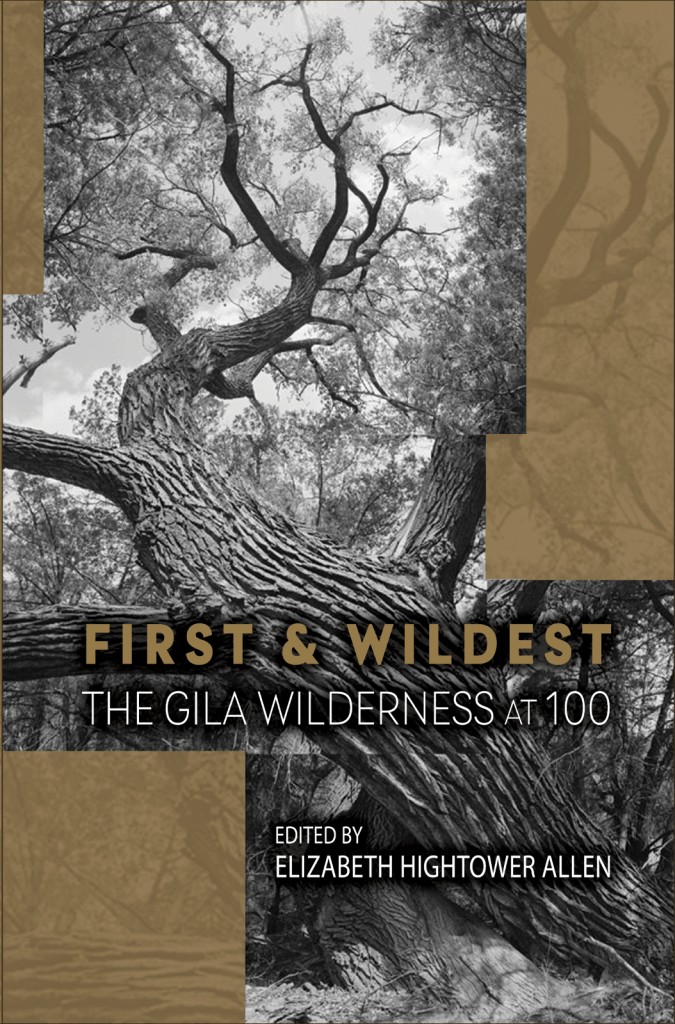
The following comment was written by Forrest Fleischman and posted here, but I believe it deserves it’s own post, so here it is. Here’s a link to the Fleischman, et al original paper, “US Forest Service Implementation of the National Environmental Policy Act: Fast, Variable, Rarely Litigated, and Declining.” Also, here’s all the raw data (which the U.S. Forest Service has notoriously—and intentionally?—made nearly impossible to locate, for many years). – mk
Hi Sharon,
It’s an honor to have one’s work being seen as important enough to merit a response. This being said, as the lead author of the original paper, there were two surprising things about this publication.
First of all, in the scientific process, the norm is to inform the original authors of a paper that a critique of their paper is being published, and give them an opportunity to respond in the same issue. We were not given such an opportunity, and this reflects poorly on JOF as a scientific publisher. We learned about the critique the same way you did, I just read this paper yesterday.
Second, we can’t figure out what Morgan et al. disagree with us about. For example, they highlight that the length of time for analysis varies between CEs, EAs, and EISs, which was something we highlighted in our original paper. They highlight some regional differences, and our original paper included an extensive discussion of regional and local differences.
You highlight that they take issue with our statement about Forest Service budgets (which they erroneously describe as “one of our conclusions”). We reported that the number of NEPA analyses was declining over the time period of study, and wrote “This decline is likely related to the combination of flat or declining real budget allocations, retirement of experienced staff without adequate replacements, and increasing fire impacts that divert agency resources away from routine land management (National Interagency Fire Center 2019)” – so we wrote a *clearly* speculative sentence, including declining budgets as one of several well documented issues the agency faces, and cited an *agency* source which discussed these problems (elsewhere in the paper we cite a whole bunch of other sources that document flat or declining agency budgets in the face of rising fire costs). Although we presented this work in language that was clearly speculative, I haven’t found anyone who disagrees with it – including Morgan et al! Morgan et al. look in more detail than we did at the budget and what did they find? Flat or declining budgets (they frame one budget measure as a slight increase but the increase isn’t statistically significant, which is to say, its what a scientist would call no change – looking at the graph presented in their paper, that budget declined through most of the study period, and then had a modest increase in the last few years of data, so even if the increase had been statistically significant, most of our study data was produced in a period of declining budgets).
As far as the data cleaning issues they highlight, give me a break. We spent hours on the phone with PALS people working with them to try to understand the data (and the many data cleaning issues it contains). We spent months cleaning this data before publishing it, and like any good scientist, ran many versions of our analysis using different assumptions about which data were good. Most of the patterns we report are robust to just about any data cleaning assumption. We decided to not analyze the data for ongoing projects because from speaking with the PALS people, we learned that we would not be able to clearly distinguish projects that were discontinued or dropped from those that were suspended from those that were ongoing. Put in other words, since the incomplete projects are ambiguous, analyzing those data are not likely to be very meaningful. According to the people who manage the PALS database, many of the projects that Morgan et al. report having long time frames that are not completed are likely to be projects that were dropped (but were not listed as so in PALS), hence the long time frames. And including the incomplete projects doesn’t actually lead to very different results – as Morgan et al. themselves show. In fact, they don’t point to any data cleaning decisions we made that change any actual results in substantively meaningful ways.
We are debating whether we should write a response to Morgan et al., but its hard to write a response when its apparent that your critic’s analysis almost entirely supports your original analysis. Or to put it in other words, we think Morgan et al. could have written a better paper if they had written it not as a critique of our work (which they don’t really succeed in because their findings aren’t substantively different from ours), but as an addition. I found some of their work interesting on first glance, although I haven’t really been through it in alot of detail yet. For example, the detailed analysis of budgets they did seems valuable (and seems to be consistent with our original story), and its interesting to know that litigation is more common in Region 1 (again, this illustrates a point we made in our original paper, i.e. that there appears to be alot that could be learned by studying regional and forest level variation inside of the agency). We ran numerous analyses, but I don’t recall looking at litigation broken down by region.
There’s lots that can – and probably should be – done with this kind of data. I strongly agree with you that its a shame that the data isn’t collected in a cleaner manner – and it ought also to be openly publicly available – there’s no reason other than a modest investment in building an interactive public-facing web portal – that it can’t be shared openly and in real time with the public. We shouldn’t need a bunch of academics to spend a few months cleaning data when the data should be clean and publicly available in the first place.
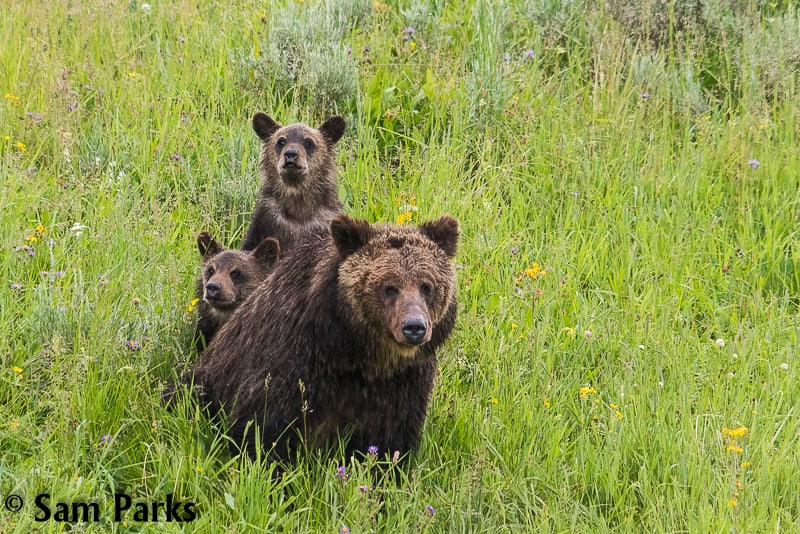
Press release from WildEarth Guardians and allies is pasted below, and right here.
WEST YELLOWSTONE, MONTANA— Following a challenge by multiple conservation groups, the U.S. Forest Service announced Thursday that it was halting a plan to clearcut more than 4,600 acres of native forests, log across an additional 9,000 acres and bulldoze up to 56 miles of road on lands just outside Yellowstone National Park in the Custer Gallatin National Forest.
In April, the Center for Biological Diversity, WildEarth Guardians, Alliance for the Wild Rockies and Native Ecosystems Council challenged the South Plateau project, saying it would destroy habitat for grizzly bears, lynx, pine martens and wolverines. The logging project would have destroyed the scenery and solitude for hikers using the Continental Divide National Scenic Trail, which crosses the proposed timber-sale area.
“This was another one of the Forest Service’s ‘leap first, look later’ projects where the agency asks for a blank check to figure out later where they’ll do all the clearcutting and bulldozing,” said Adam Rissien, a rewilding advocate at WildEarth Guardians. “Logging forests under the guise of reducing wildfires is not protecting homes or improving wildlife habitat, it’s just a timber sale. If the Forest Service tries to revive this scheme to clearcut native forests and bulldoze new roads in critical wildlife habitat just outside of Yellowstone, we’ll continue standing against it.”
In response to the group’s challenge, the Forest Service said it was withdrawing the South Plateau project until after it issues a new management plan for the Custer-Gallatin National Forest this summer. Then it plans to prepare a new environmental analysis of the project with “additional public involvement” to ensure the project complies with the new forest plan.
“This is a good day for the greater Yellowstone ecosystem and for the grizzlies, lynx and other wildlife that call it home,” said Ted Zukoski, a senior attorney at the Center for Biological Diversity. “The Forest Service may revive this destructive project in a few months, but for now this beautiful landscape is safe from chainsaws and bulldozers.”
The project violated the National Environmental Policy Act by failing to disclose precisely where and when it would bulldoze roads and clearcut the forest, which made it impossible for the public to understand the project’s impacts, the groups said in their April objection. The project allowed removal of trees more than a century old, which provide wildlife habitat and store significant amounts of carbon dioxide, an essential component of addressing the climate emergency.
“The South Plateau project was in violation of the forest plan protections for old growth,” said Sara Johnson, director of Native Ecosystems Council and a former wildlife biologist for the Custer Gallatin National Forest. “The new forest plan has much weaker old-growth protections standards. That is likely why they pulled the decision — so they can resign it after the new forest plan goes into effect.”
“The Forest Service needs to drop the South Plateau project and quit clearcutting old-growth forests,” said Mike Garrity, executive director of the Alliance for the Wild Rockies. “Especially clearcutting and bulldozing new logging roads in grizzly habitat on the border of Yellowstone National Park.”

Here’s the coalition press release:
WASHINGTON—Conservation groups filed a lawsuit today challenging the Bureau of Land Management and U.S. Forest Service’s 2020 approval of a plan that allows fracking across 35,000 acres of Colorado’s Western Slope. The North Fork Mancos Master Development Plan allows 35 new fracking wells in the North Fork Valley and Thompson Divide areas of the Grand Mesa, Uncompahgre and Gunnison National Forest.
Today’s lawsuit says federal agencies violated the National Environmental Policy Act and other laws by failing to fully assess the potential for water pollution and harm to the climate, and by refusing to analyze alternatives that would minimize or eliminate harm to the environment. The plan would result in about 52 million tons of greenhouse gas pollution, equivalent to the annual pollution from a dozen coal-fired power plants.
“This case is about confronting the Trump administration’s complete disregard of law, science, and public lands,” said Jeremy Nichols, Climate and Energy program director for WildEarth Guardians. “We can’t frack our way to a safe climate and we certainly can’t afford to keep letting the oil and gas industry run roughshod over Colorado’s irreplaceable and vital public lands.”
“The Trump administration charted a course to destroy public lands and our shared climate,” said Peter Hart, staff attorney at Wilderness Workshop. “This master development plan is a 30-year commitment to the disastrous ‘energy dominance’ agenda which ignored significant impacts on the communities and spectacular values of the North Fork. We are determined to hold our federal government accountable to a more sustainable future for Colorado’s public lands, wildlife, people, and climate.”
“Fossil fuel development and sustainable public lands don’t mix, especially in the roadless headwaters of the Upper North Fork Valley,” said Brett Henderson, executive director of Gunnison County-based High Country Conservation Advocates. “This project is incompatible with necessary climate change action, healthy wildlife habitat, and watershed health, and is at odds with the future of our communities.”
“We are in a megadrought in the North Fork Valley and the Western Slope. The water used to frack in the watershed risks precious water resources and only exacerbates the climate and the water crisis,” said Natasha Léger, executive director of Citizens for a Healthy Community. “This 35-well project is the beginning of much larger plans to extract a resource that should be left in the ground and for which the market is drying up.”
“This dangerous plan promises more runaway climate pollution in one of the fastest-warming regions in the United States,” said Taylor McKinnon of the Center for Biological Diversity. “We’re suing to force federal agencies to stop ignoring the climate emergency. Like the planet, the Colorado River Basin can’t survive a future of ever-expanding fossil fuel development.”
“It is past time for the federal government to meaningfully consider climate change in its oil and gas permitting decisions,” said Melissa Hornbein, attorney at the Western Environmental Law Center. “Gunnison and Delta Counties have already exceeded 1.5°C of warming; the project failed to meaningfully analyze impacts to climate, roadless areas, and the agriculture and eco-tourism centered economies of the North Fork Valley. More drilling is projected to harm Delta County’s tax revenue, not help it. These communities need land management that serves the public interest.”
Colorado’s Western Slope is already suffering from severe warming. The Washington Post recently featured the area as the largest “climate hot spot” in the lower 48 states, where temperatures have already risen more than 2 degrees Celsius, reducing snowpack and drying Colorado River flows that support endangered fish, agriculture and 40 million downstream water users.
In January 574 conservation, Native American, religious and business groups sent the then president-elect a proposed executive order to ban new fossil fuel leasing and permitting on federal public lands and waters. In February the Biden administration issued an executive order pausing oil and gas leasing onshore and offshore pending a climate review of federal fossil fuel programs. In June the Interior Department will issue an interim report describing findings from a March online forum and public comments.
Background: Fossil fuel production on public lands causes about a quarter of U.S. greenhouse gas pollution. Peer-reviewed science estimates that a nationwide fossil fuel leasing ban on federal lands and oceans would reduce carbon emissions by 280 million tons per year, ranking it among the most ambitious federal climate-policy proposals.
Oil, gas and coal extraction uses mines, well pads, gas lines, roads and other infrastructure that destroy habitat for wildlife, including threatened and endangered species. Oil spills and other harms from offshore drilling have inflicted immense damage to ocean wildlife and coastal communities. Fracking and mining also pollute watersheds and waterways that provide drinking water to millions of people.
Federal fossil fuels that have not been leased to industry contain up to 450 billion tons of potential climate pollution; those already leased to industry contain up to 43 billion tons. Pollution from the world’s already producing oil and gas fields, if fully developed, would push global warming well past 1.5 degrees Celsius.
Press release from Western Environmental Law Center.
On the same day as the Trump administration announced the elimination of 3.4 million acres of critical habitat for the northern spotted owl, the U.S. Fish and Wildlife Service’s top owl expert formally objected to the decision in a document recently unearthed as part of ongoing litigation. The Jan. 15 memorandum, written by Oregon State Office Supervisor for the U.S. Fish and Wildlife Service Dr. Paul Henson, found that “it is reasonable to conclude that [the reduction in critical habitat] will result in the extinction of the [northern spotted owl].” The Henson memo references other documents, as yet unreleased, indicating this was not the first warning of the dire consequences of the proposed rule. On Dec. 9, 2020, Dr. Henson likewise warned, “Most scientists (myself included) would conclude that such an outcome will, therefore, result in the eventual extinction of the listed subspecies.”
“We now know what we suspected all along, which is that the Trump administration actively disregarded the best available science when making wildlife and land management decisions,” said Susan Jane Brown, attorney at the Western Environmental Law Center. “Seeing in writing that callous disregard for the continued existence of this iconic species is sobering, to say the least, and revolting at worst. This is a clear example, and unfortunately not the first, of the prior administration giving out gifts to political allies rather than following the law. Thankfully, experts at the U.S. Fish and Wildlife Service stood up for the northern spotted owl, and WELC and our clients are in court to ensure that the best available science rules the day.”
“We suspected that political favors, not science, guided the last-minute rulemaking change by the Trump administration,” said Tom Wheeler, executive director of the Environmental Protection Information Center (EPIC). “Now we know that it was made clear to the Trump administration that its planned cuts to northern spotted owl critical habitat would result in the owl’s extinction. They knew but didn’t care.”
The Henson memo was written in response to a separate memo, signed by then-U.S. Fish and Wildlife Service Director Aurelia Skipwith, which outlined the legal and scientific justifications for the reduction in critical habitat. The Jan. 7, 2021 memorandum was reportedly not provided to Dr. Henson until the day before the formal rulemaking, making a more timely objection impossible.
This is not the first time that political appointees have personally inserted themselves into controversial decisions. In 2007, Julie MacDonald, then deputy assistant secretary for Fish and Wildlife and Parks at the Department of the Interior, was found to have manipulated decisions and agency science to benefit the Bush administration’s political agenda. The Interior Department under Interior Secs. Ryan Zinke and David Bernhardt have also been subject to a number of high-profile ethics scandals. Given this history, after the Jan. 15 critical habitat rule, eight Western lawmakers requested a formal investigation as to whether any government official improperly “inserted themselves into the scientific process in order to achieve preferred policy outcomes….”
The Biden administration has paused implementation of the Trump-era critical habitat rule until December, signaling its intent to formally reverse or revise the rule. Meanwhile, the timber industry has already filed suit against the delayed implementation and Congressional Republicans are lining up behind the timber industry, urging the immediate implementation of the Trump rule.
General background:
Timber harvesting in the Northwest has resulted in a widespread loss of spotted owl habitat across its range, which was a main reason for listing the species in 1990. Owls depend on habitat provided by the dense canopy of mature and old-growth forests; unfortunately, those forests are still a target for logging throughout the bird’s historic range. The northern spotted owl is already functionally extinct in its northernmost range, with only one recognized breeding pair left in British Columbia.
In response to a court order, in 1990 the Service listed the northern spotted owl as threatened, citing low and declining populations, limited and declining habitat, competition from barred owls, and other factors in the bird’s plight. Even after its listing, northern spotted owl populations have declined by 70%, and the rate of decline has increased.
In response to a petition filed by the Environmental Protection Information Center, in December 2021, the U.S. Fish and Wildlife Service determined that “uplisting” the owl from “threatened” to “endangered” was “warranted but precluded by higher priority actions.”